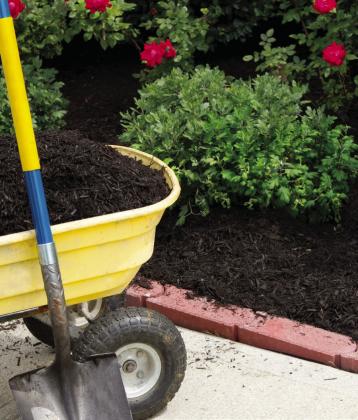ONE OF THE MOST COMMON QUESTIONS nurseryandgardencenter employees hear from their customers is some variation upon, “How can I create a landscape that doesn’t require any maintenance?” This is understandable considering many people today lead extremely busy lives and can’t realistically accommodate another major obligation in their schedule.
While there’s really no such thing as a “plant-it-and-forget-it” landscape, it is possible—with a little forethought and planning—to have a low-maintenance landscape that requires only a modest investment of time and effort once established. Here, in no particular order, are some steps that can help you achieve this objective:
Mulch your planting beds
Mulching will not only make your planting beds appear much more attractive and unified, but it will also serve a few important utilitarian purposes. A two- or three-inch layer of mulch will help retain moisture in the soil, thereby minimizing the chore of watering, as well as greatly reduce weed growth so you’ll spend much less time on your hands and knees pulling those invasive plants later on.
Choose native and/or drought tolerant plants Plants native to your area will demand far less effort than non-natives when it comes to fertilizing, watering, pest control, and other care requirements because they’re already well adapted to thrive in your local conditions and climate zone. For sunny areas of your landscape, consider choosing drought-tolerant plant varieties, such as yuccas and various sedums, which will allow you to cut back significantly on watering compared to thirstier plants.
Choose lower-maintenance cultivars Nowadays, you can often choose from newer plant cultivars that are relatively trouble-free compared to older varieties. Roses, for instance, have come a long way in this regard. Compared to heirloom varieties, many modern rose cultivars are much more disease-resistant so you’re not constantly spraying for problems such as blackspot or powdery mildew. Some are also “self-cleaning,” meaning faded blooms naturally fall from the plants so they require little to no deadheading. Be sure to read those plant tags to find hassle-free varieties that appeal to you.
Account for plant growth potential
When designing your landscape, be sure to consider the mature size of all the plants you intend to include. Otherwise, you might be tempted to overstuff your planting beds so they don’t look sparse initially but then end up with an overgrown mess that requires frequent, heavy pruning or even movement of plants just to maintain separation. The maximum height and spread of each plant should be indicated on its label at the nursery.
Put perennials to good use
A bed of flowering annuals can be stunning, but you have to replant it each growing season. Perennials, on the other hand, come back from the roots year after year (assuming they’re given proper care), so substituting them for annuals where possible can help reduce the demands of your landscape. However, some perennials are more carefree than others, so, again, be sure to read those plant tags or consult with the professionals at your local garden center for advice.
Automate irrigation
Watering is an unavoidable chore if you hope to maintain a healthy, attractive landscape. However, in many circumstances, it’s possible to automate this process to at least some degree so you don’t have to stand there with hose in hand or repeatedly move a sprinkler aroundyourproperty.Automatingyour irrigation can be as simple as running a permanent soaker hose through the planting bed and around the base of each plant so all you have to do is turn on the faucet when it’s time to water. Or, you could install an actual drip irrigation system that delivers water to each plant in precise fashion through a series of hoses, nozzles, and tubes.
Maximize hardscaping
Hardscaping—i.e. non-living, durable elements in the landscape consisting of materials such as concrete, stone, brick, or wood—often requires an upfront investment of cash, time, and sweat equity, but can save you a lot of effort in the long run. Patios, pathways, decks, pergolas, fountains, and fire pits are just some of the hardscaping options that not only enhance the aesthetics and utility of your outdoor living space, but also require no watering, fertilizing, pruning, or spraying, and little to no weeding. Even better, hardscaping helps reduce the overall area of lawn you need to mow and treat throughout the growing season.
Of course, this is just a sampling of ideas that will help take the hassle out of maintaining a landscape. Consult with local lawn and garden professionals or landscaping experts for further guidance on now to create and enjoy a low-maintenance landscape. ✲


